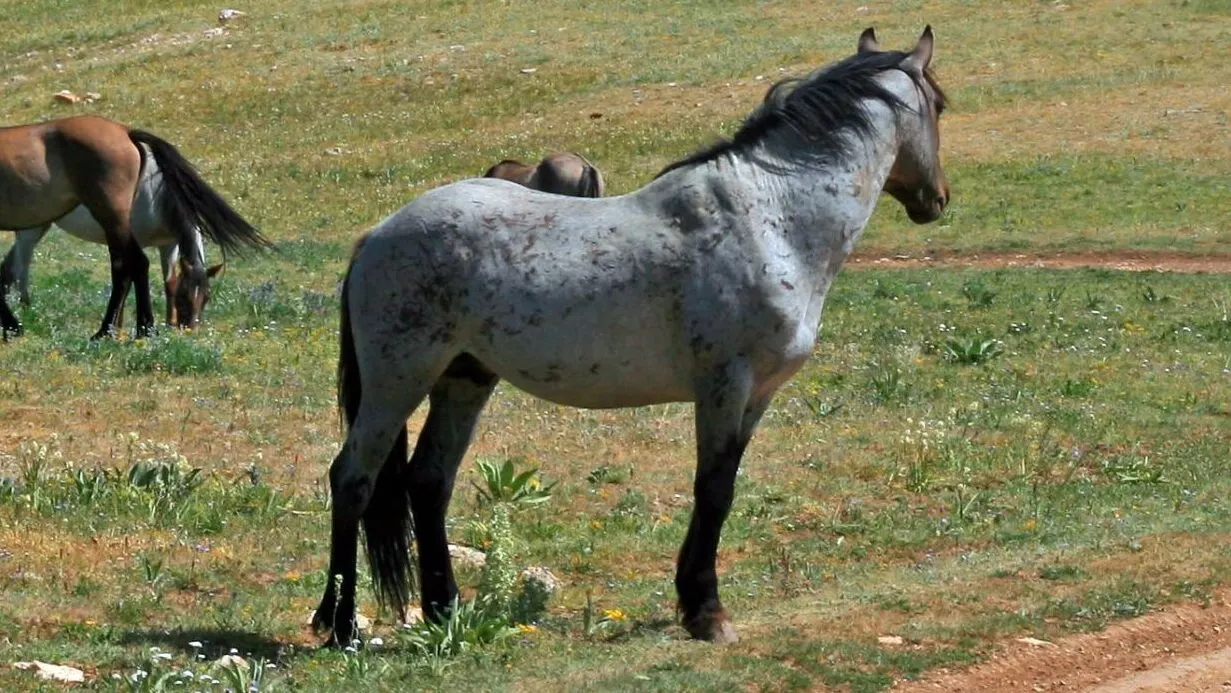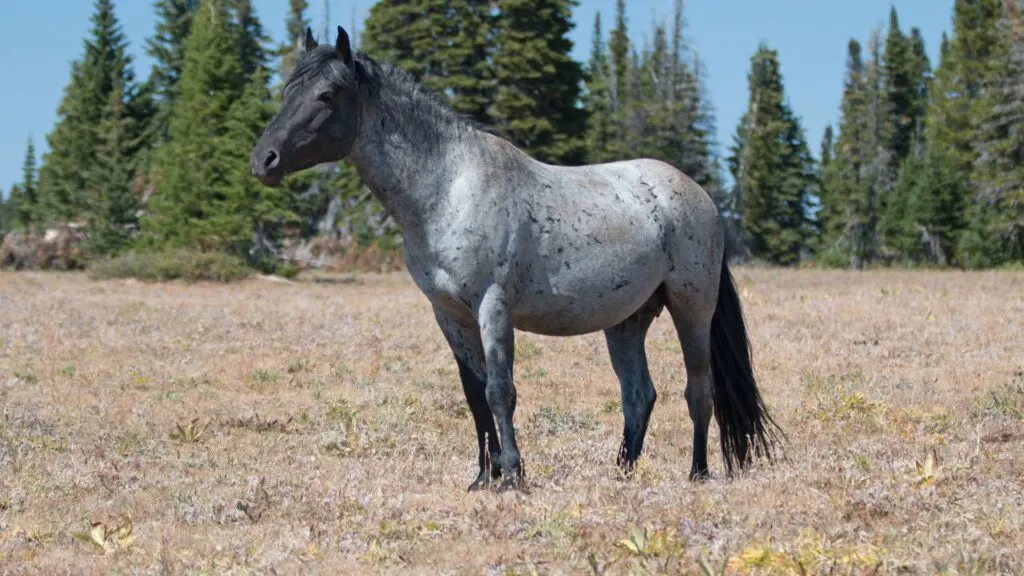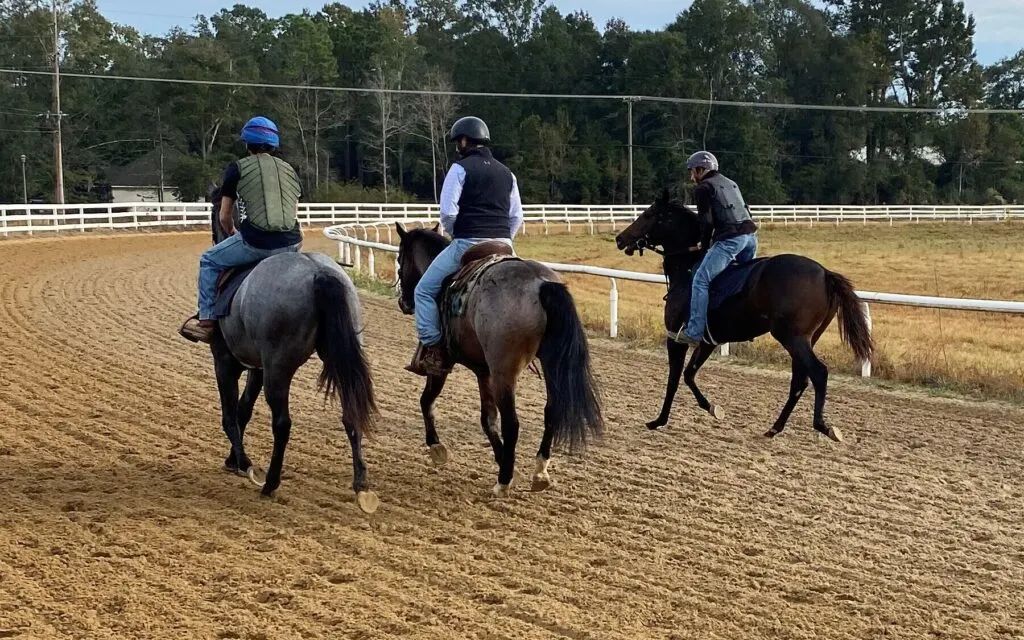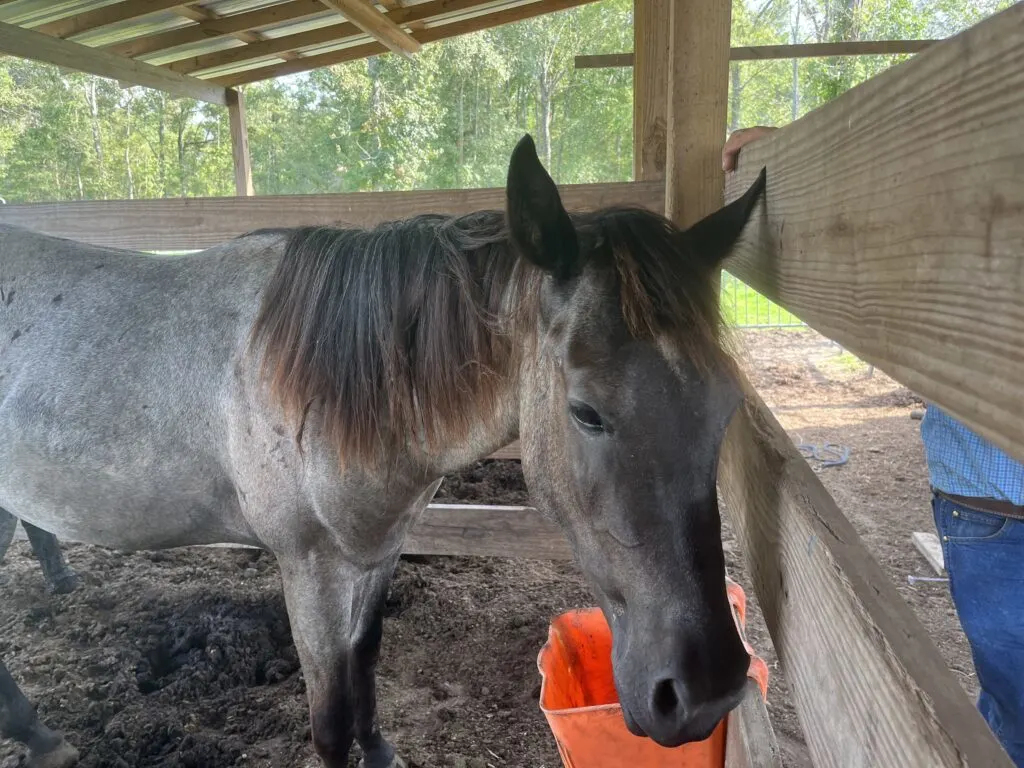Last updated: April 8, 2024
Have you ever seen a horse with a coat that looks like the night sky sprinkled with stars? That’s probably a blue roan horse. Their coats are a mix of black and white hair, making them look stunningly blue-gray and stand out among other horses.
As someone who’s owned horses for years, written books about them, and spent a lot of time riding, I find blue roan horses especially interesting. Let’s dive in and learn more about the beautiful blue roan horses together.

What Is a Blue Roan Horse?
Blue roan refers to horses with a striking blue-gray coat resulting from unique genetic traits and visually dynamic physical characteristics. This distinctive coloration sets the blue roan apart in the equine world.
Identifying a blue roan horse is about observing their coat. They have a mix of black and white hairs, giving them a unique blue-gray look. It’s this mix of hairs that sets them apart from purely black horses or those with a dark bay coat, which might look similar at first glance.
Unlike gray horses that become lighter with age, blue roans keep their color, which doesn’t change much over time. However, they can seem darker or lighter depending on the season or their diet.
Characteristics of a Blue Roan Horse’s Coat
- The coat of a blue roan can appear to change with the seasons or as the horse ages.
- The coat may darken in winter, showing a deeper blue, while it might lighten to a softer grayish-blue in the summer.
- These changes are due to new hair growth and the shedding process, affecting the coat’s visual intensity.
The Genetics of Blue Roan Horses
To produce a blue roan horse, specific genetic conditions must align. The unique blue-gray coat comes from a mix of the Roan gene (Rn) on a black base coat, requiring at least one parent to possess black horse genes (E_aa) and one to carry the Roan gene.
Breeding for this color involves understanding the genetics of roan and black coats, aiming for a combination that results in the distinctive blue roan coloration. Genetic testing, like roan zygosity tests, can help breeders identify the best candidates for producing blue roan offspring.

Breeds That Can Be Blue Roan
Blue roan horses are admired for their stunning blue-gray coats, found across various horse breeds. Here’s a concise overview of breeds known for their blue roan members:
- American Quarter Horse: Recognized by the American Quarter Horse Association, which registers seventeen colors, including blue roan.
- Percheron: Traditionally black or grey, Percherons also come in blue roan. Originating from France, they’re known for their strength and were once the largest draft horse registry.
- Belgian: Mostly bay or chestnut in the U.S., blue and red roan Belgians are more common in Europe. Known for their size, strength, and docile nature, Belgians excel in pulling competitions.
- Welsh Pony and Cob: These ponies come in various colors, including blue roan. They range from 11 to 14.2 hands; and they’re versatile and used in chariot races, rodeos, and as ranch ponies.
- American Paint Horse: Known for their colorful coats, including blue roan. They feature patterns like tobiano, overo, and tovero, with the American Paint Horse Association registering even solid-colored horses as “Solid Paint Bred.”
- Paso Fino: This breed accepts all colors, including blue roan. Known for their smooth gaits, Paso Finos are a naturally gaited breed with incredible strength, averaging around 14.1 hands tall.
- Mustang: Mustangs are feral horses. You’ll find them in various colors, including blue roans. Descended from Spanish horses, they roam free in the western U.S. and are legally protected.
- Standardbred: Primarily used in harness racing but also popular for pleasure riding. While mostly bay, black, or brown, blue roans are among the colors found in this versatile breed.
- Tennessee Walking Horse: These gaited horses are known for their smooth ride and are available in various colors, including blue roan. They’re used in therapeutic riding, trail riding, and show competitions due to their gentle nature.

Identifying a True Blue Roan Horse
To tell if a horse is a true blue roan, check if it has a mostly black coat with some white hairs. This combination gives them a special blue-gray look. Unlike other horses that might change color with seasons, a blue roan’s color stays pretty much the same all year, though it might get slightly lighter or darker.
If you’re not sure, genetic testing can prove if a horse is a true blue roan, setting them apart from horses that look similar but aren’t blue roans.
Care and Management of Blue Roan Horses
Caring for blue roan horses involves standard practices such as balanced nutrition, clean water, routine health checks, and vaccinations. Regular grooming is crucial, not only for their striking coat but also for spotting any potential skin issues early.
Importantly, hoof care should not be overlooked; regular trimming and checks for signs of discomfort or disease ensure their hooves remain healthy and functional. Like all horses, blue roans benefit from attentive, overall care tailored to their environment and activity level.

The Significance of Blue Roan Horses in History and Culture
Blue roan horses have been admired and valued throughout history and across cultures for their stunning appearance and versatility. Traditionally, these horses were sought after for their strength and resilience, playing significant roles in agriculture, transportation, and battle.
In some cultures, blue roan horses were symbols of status and wealth, believed to carry good fortune. Their distinctive coloration and hardy nature have made them a subject of folklore and art, reflecting their impact on human society and our enduring fascination with these remarkable animals.

Ten Best Blue Roan Horse Names
Choosing the perfect name for a blue roan horse can be a challenge, with the aim to reflect their unique coat color and individual personality. Here are my favorite names inspired by their blue-gray hues and the essence of these horses:
- Mystic Shadow – Captures the mystical allure and shadowy tones of the blue roan’s coat.
- Stormy Skies – Reflects the dynamic, storm-like appearance of their unique coloring.
- Blue Moon – A nod to the rare and beautiful occurrence, much like the rarity of the blue roan color.
- Silver Mist – Evokes the image of a gentle, silvery mist over a dark landscape, mirroring the horse’s coat.
- Twilight Haze – Suggests the dusky, mysterious quality of their coloration at twilight.
- Sapphire Dream – For a horse that embodies the beauty and depth of sapphire under the sun.
- Frostbite – A cool name that hints at the icy blue and gray tones of the roan coat.
- Blue Echo – Symbolizes the impression the horse’s striking color leaves on all who see it.
- Indigo Wind – Combines the deep blue of indigo with the swift, free nature of the wind.
- Celestial Blue—Inspired by the heavenly shades of blue of the night sky, this color is perfect for a horse with a coat that seems to hold the universe.

Unique Roan Traits
Roan horses, including blue roans, exhibit several fascinating traits that set them apart from other color variations in the equine world. Here’s an exploration of these unique characteristics:
- Coloration from Birth: Unlike grey horses, which may be born dark and gradually lighten with age, roans display their distinctive coloring right from birth. While a roan foal’s coat may undergo seasonal lightening, its overall coloration remains consistent as it matures.
- Mane Color Changes: An intriguing observation from my experience with blue roan foals is their red manes at birth, which typically turn black by the age of two. It’s unclear if this is a widespread phenomenon among all blue roan foals or a unique feature of those I’ve encountered.
- Roan Varieties: Roans are primarily categorized into three types based on their base coat color: red roan (chestnut base), blue roan (black base), and bay roan (bay base). Each variety presents a unique blend of base color and white hair, contributing to the diversity within the roan classification.
- Corn Marks: When a roan horse sustains a cut or scrape, the regrown hair in the injured area is solid-colored, lacking the white hairs typical of the roan pattern. This phenomenon, known as a “corn mark,” highlights the roan coat’s unique response to injury.
- Reverse Dapple: Roan horses exhibit a distinctive pattern known as reverse dapple, where dapple appears as lighter circles against their coat, contrasting to the dark circles seen in non-roan horses. This reverse dappling adds another layer of visual interest to the roan’s already captivating appearance.

FAQs About Blue Roan Horses
Are blue roan horses rare?
Blue roan horses aren’t rare but are less common than other roan varieties. Their availability can vary by breed and location, with some breeds like Quarter Horses, more likely to have blue roans.
What makes a horse a blue roan?
A blue roan horse has a genetic combination that results in a coat mixed with black and white hairs, giving it a distinctive blue-gray appearance. This is due to the presence of the Roan gene on a black base coat.
Is a blue roan horse more expensive than horses of other colors?
The price of a blue roan horse depends more on factors like conformation, pedigree, and training rather than its coat color. While a beautiful coat color like blue roan can be desirable, it typically does not significantly increase a horse’s price.
Can the coat color of a blue roan horse change over time?
While the roan pattern remains consistent, the visibility of the blue roan color can change slightly with the seasons due to the shedding and growth of the coat. However, the fundamental blue-gray appearance remains.
Can any horse breed be a blue roan?
While not every horse breed can be a blue roan, many breeds do have blue roan members. Common breeds include the American Quarter Horse, Tennessee Walking Horse, and the Percheron.

Conclusion
Blue roan horses captivate with their unique beauty, defined by a blend of black and white hairs that create their signature blue-gray coat. This distinctive coloration, resulting from a specific genetic makeup, sets them apart in the equine world.
While not the rarest, the blue roan’s allure is undeniable, varying in shade depending on the density of white hairs. Blue roan horses embody a remarkable combination of genetics, beauty, and rarity. Their captivating coat color distinguishes them within the vast spectrum of horse colors and highlights the fascinating interplay of genetics and environment in determining equine beauty.
Take Action and Learn More
Eager to dive deeper into the world of blue roan horses and the broader equine community? Explore these resources for comprehensive insights, registration details, and engaging stories about the majestic blue roan and other horse colors:
- Roan Zygosity Test: UC Davis Veterinary Medicine.
- How To Tell What Color Your Foal Will Be. American Quarter Horse Association (AQHA)
- Youth & Young Adult Programs: Engage with programs designed for young equestrians, offering a wealth of learning and development opportunities. Learn more at AQHA Youth.
- News and Publications: Stay updated with the latest news, research, and publications in the equine world, enriching your knowledge and understanding of various horse breeds and colors. Check out American Roan Horse.

Whether you’re a seasoned equestrian or new to the horse community, these resources offer valuable information to enhance your journey with horses, especially the captivating blue roan.
